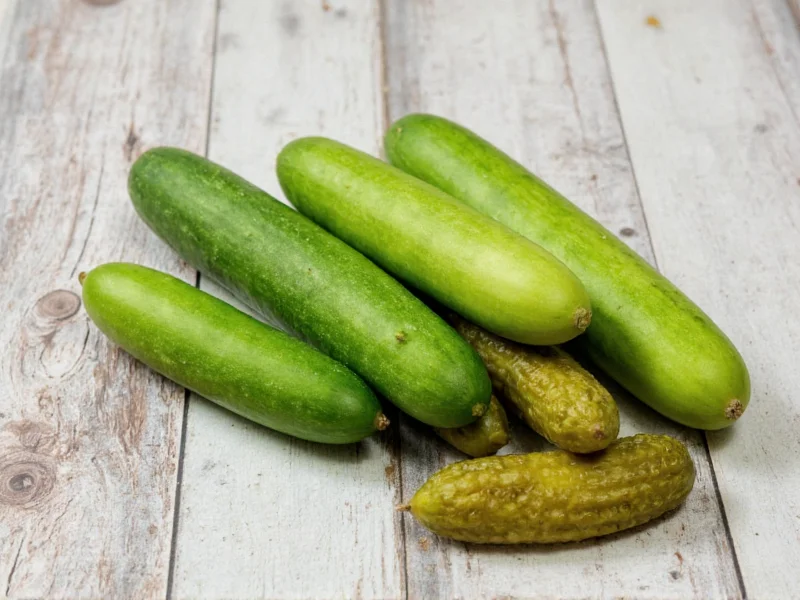Many people wonder about the relationship between cucumbers and pickles, often assuming they're completely different vegetables. This confusion stems from their distinct appearances, textures, and flavors. Let's explore the science and culinary traditions behind these related but distinct food items.
The Botanical Reality: Cucumbers as the Foundation
Cucumbers (Cucumis sativus) are fresh vegetables belonging to the gourd family. They're composed of approximately 95% water and have a mild, slightly sweet flavor when raw. The specific cucumber varieties used for pickling—often called "pickling cucumbers"—are typically smaller, firmer, and have thinner skins than slicing cucumbers.
When these cucumbers undergo the pickling process, they transform into what we commonly call pickles. This preservation method has been used for thousands of years across various cultures to extend the shelf life of seasonal produce.
The Science of Transformation: How Cucumbers Become Pickles
Pickling occurs through two primary methods, each creating distinctly different products:
| Pickling Method | Process | Resulting Product | Shelf Life |
|---|---|---|---|
| Fermentation Pickling | Cucumbers submerged in saltwater brine allowing natural bacteria to produce lactic acid | Sour pickles, kosher dills | Several months refrigerated |
| Vinegar Pickling | Cucumbers immersed in vinegar-based solution, often heated | Bread and butter pickles, sweet pickles | 1-2 years unopened |
The chemical changes during pickling significantly alter the cucumber's properties. The acid environment breaks down pectin, softening the texture while preserving crunch. Natural sugars convert to acids, creating the characteristic sour flavor profile that distinguishes pickles from fresh cucumbers.
Nutritional Transformation: Fresh vs. Pickled
While both originate from the same vegetable, the nutritional profiles differ substantially:
- Calorie content: Pickling slightly increases calories due to added sugars in some recipes
- Sodium levels: Pickles contain significantly more sodium (300-1000mg per pickle vs. 2mg in fresh cucumber)
- Vitamin retention: Vitamin C decreases during pickling, while some B vitamins increase through fermentation
- Probiotics: Fermented pickles contain beneficial bacteria absent in fresh cucumbers
Understanding these nutritional differences helps address common questions about whether pickles offer similar health benefits to fresh cucumbers. While both provide hydration and certain nutrients, their dietary impacts vary significantly due to the pickling process.
Culinary Applications: When to Use Each
Chefs and home cooks select between fresh cucumbers and pickles based on desired flavor profiles and textures:
- Fresh cucumbers work best in salads, sandwiches where crunch is desired, and cold soups like gazpacho
- Dill pickles provide tangy contrast in burgers, sandwiches, and charcuterie boards
- Sweet pickles complement strong-flavored meats and add brightness to potato salads
- Pickled cucumber relish enhances fish tacos and grilled meats
The acidity in pickles can cut through rich flavors, making them valuable culinary components beyond simple garnishes. Their preserved nature also makes them pantry staples with extended usability compared to fresh cucumbers' limited shelf life.
Common Misconceptions Clarified
Several myths persist about cucumbers and pickles that deserve clarification:
- "Gherkins are a different vegetable" – Gherkins are simply a specific variety of small cucumber bred for pickling
- "All pickles are sour" – Sweet pickles contain added sugar, while bread and butter varieties balance vinegar with sweetness
- "Pickling destroys all nutrients" – While some vitamins decrease, fermentation creates beneficial compounds not present in fresh cucumbers
- "Pickles aren't healthy because of vinegar" – Vinegar's acetic acid offers potential metabolic benefits when consumed in moderation
Practical Considerations for Consumers
When selecting between cucumbers and pickles, consider these practical factors:
- Shelf life: Fresh cucumbers last 1-2 weeks refrigerated, while properly canned pickles maintain quality for 1-2 years
- Sodium content: Low-sodium pickle options exist for those monitoring salt intake
- Organic options: Both organic cucumbers and organic pickles are available, though fermentation pickles may contain naturally occurring sulfites
- Homemade potential: Quick refrigerator pickles offer a middle ground between fresh cucumbers and shelf-stable varieties
Understanding these practical differences helps consumers make informed choices based on dietary needs, culinary applications, and storage requirements. The relationship between cucumbers and pickles represents one of food science's most successful preservation techniques, transforming a highly perishable vegetable into a versatile, long-lasting pantry staple.
Are pickles and cucumbers the same thing?
No, pickles are cucumbers that have undergone the pickling process. All pickles start as cucumbers, but not all cucumbers are pickles. The pickling transformation changes their texture, flavor, and nutritional properties through either fermentation or vinegar immersion.
What's the difference between pickling cucumbers and regular cucumbers?
Pickling cucumbers are typically smaller (3-4 inches long), have thinner skins, and fewer seeds than slicing cucumbers. They're bred specifically for pickling because they maintain better texture during the preservation process. Regular cucumbers often become too soft when pickled.
Are pickles healthier than fresh cucumbers?
Both offer health benefits but with important differences. Fresh cucumbers have minimal sodium and more vitamin C, while fermented pickles contain probiotics. Pickles generally have higher sodium content but provide beneficial bacteria. Neither is categorically healthier—the better choice depends on individual dietary needs and health goals.
Can you make pickles from any cucumber?
Technically yes, but results vary significantly. Standard slicing cucumbers often become mushy when pickled due to higher water content and thicker skins. For best results, use varieties specifically bred for pickling like Kirby, Persian, or Gherkin cucumbers, which maintain crunch and absorb flavors better during the preservation process.
Why do some pickles stay crunchy while others get soft?
Crunch retention depends on several factors: using fresh, firm cucumbers; adding tannins (like grape leaves or oak leaves) to the brine; maintaining proper salt concentration; and avoiding over-processing. Cucumbers naturally contain enzymes that break down pectin—the compound that maintains cell structure—and the pickling process must counteract this to preserve texture.











 浙公网安备
33010002000092号
浙公网安备
33010002000092号 浙B2-20120091-4
浙B2-20120091-4